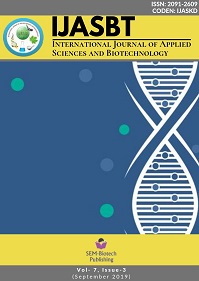Morphological Study of Pollen Grains of Angiosperms
DOI:
https://doi.org/10.3126/ijasbt.v7i3.25714Keywords:
Angiosperms, pollen grains, aceto-carmine, exine-sculptureAbstract
Pollen morphology of twelve species of angiosperms from Central Nepal was cytologically carried out in present investigation. In this investigation pollen morphology of Bignonia venusta Ker Gawl. and Jacranda mimisifolia D.Don from the family Bignoniaceae; Brassica compestris L. from Brassicaceae; Cuphea hyssopifolia Kunth. from Lythraceae; Coriandrum sativum L. from Apiaceae; Crepis japonica L. and Dichrocephala integrifolia (L f.) kunzte. from Asteraceae; Delphinium ajacis L. from Ranunculaceae; Dianthus barbetus L. from Caryophyllaceae; Euphorbia Milii Des Moul. and Euphorbia pulcherima L. from Euphorbiaceae and Magnolia fuscata from Magnoliaceae were studied. Shape of the pollen grains found to be mostly spheroidal, few circular, one elliptical, one triangular and one elongated in this study. Sculpture of exine wall found to be smooth, echidnae, tected, reticulated and perforated type. Aperture of the pollen grains found to be triporate to pentaporate. The large, medium and small sized pollen grains were observed in present research. The high diversty of sculpture type in pollen grains of angiosperms has been associated to diversity in pollination systems. Smooth pollen grains are linked with wind or water pollination while sculptured pollen grains associated with biotic pollination. The morphology of pollen grain is one of the significant tools in solving some taxonomic problems such as identification, tracing phylogenetic relationship on the family, generic or specific level and in plant systematic and evolution.
Int. J. Appl. Sci. Biotechnol. Vol 7(3): 354-358




